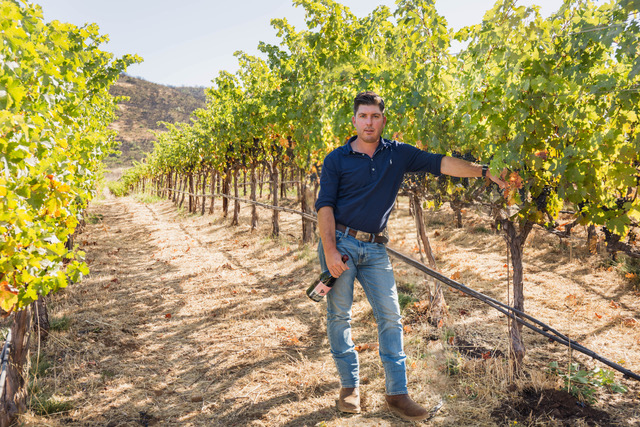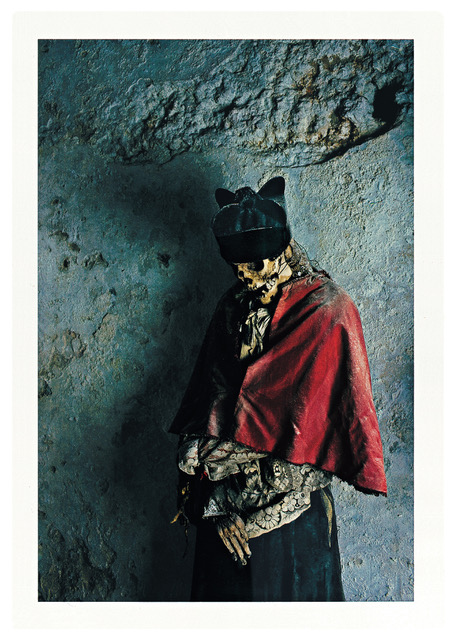This website uses cookies so that we can provide you with the best user experience possible. Cookie information is stored in your browser and performs functions such as recognising you when you return to our website and helping our team to understand which sections of the website you find most interesting and useful.
Orin Swift: moving Californian wine forward
Orin Swift winemaker Dave Phinney speaks to db about the advantages of the California AVA, how Merlot can recover from “the Sideways effect”, and why there is a mummy on one of his wine labels.

Phinney, who grew up in Los Angeles, described his ending up in the wine world as a “total accident”: “I was studying Political Science, Law and History and thought I wanted to go to law school. I was interning at the Public Defenders Office and also working for congressman, and realised that I didn’t want to be involved in the legal system or politics. I had one year left in college, and then a friend called me and told me they needed a roommate for a study abroad programme in Florence, Italy, and so [in 1995] I went out there on a whim.”
That particular friend is Tom Traverso, who now works with Orin Swift as a national sales manager, and whose family was in the wine industry in Sonoma.
During his time in Tuscany, Phinney did what might be expected of most students: “I went to Florence as a beer and whiskey guy, but we would go to the local supermarket and each get a magnum of red wine and go back to our accommodation, where 26 of us were living.”
Having worked his way through every supermarket wine that Florence had to offer, Phinney was left ruminating on what to do next: “At the end of our six month sojourn, we were sitting out on the terrace of our room, lamenting that we had to go back to the real world, and Tom said ‘have you ever thought about the wine business?’, and the light-bulb went on.”
An internship in the University of Arizona’s agriculture department and working at a wine retailer enabled Phinney to put his foot on the ladder. Learning via tasting, Phinney kept in mind the advice of Dean Sylvester, now former winemaker at Napa’s Whitehall Lane: “No matter where you are, on a plane, on a train, at dinner – sh*tty wine, great wine, good wine – just put it in your mouth and think about it for a second, because that goes into the Rolodex of all your experiences with wine.”
But, despite his considerable tasting experience, Phinney is not overly fond of the jargon commonly used for tasting notes: “I don’t take a lot of notes, if I do, they’re very succinct. I joke that there’s 27 adjectives that can be used to describe wine and they’ve all been used, so why bother?”
Armed with a well-informed palate and a good grasp of the wine business, Phinney established Orin Swift in 1998. ‘Orin’ is his father’s middle name, while ‘Swift’ is his mother’s maiden name, and also his middle name. 25 years on, and Orin Swift is considered to be an iconoclastic icon of Californian wine.
Phinney’s not one to get caught up in the romanticism of the wine world, as he stated: “It’s not the wine hobby, it’s the wine business.”
While many winemakers might preach about the beauty of individual plots, Phinney has a rather different view: “To me, the easiest way to get complexity is through geographic diversification. The reason we chose to appellate it to California is because we have this amazing state that has everything from the coolest zones, like Mendocino County in the northwest, all the way down to Santa Barbara in the south, and everything in between. There’s a lot of parts of California where there are grapes growing, but people just don’t know about them because they’re not Napa or Sonoma.”
Speaking further on the merits of the California appellation, Phinney said: “It allows us to establish a certain style and maintain consistency, because to me, there’s nothing more frustrating as a consumer than when you have an expectation of what it is going to be like, and the next year it’s twice the price and half the wine.”
“What we like to do with a blend, whether it’s red or white, is start with a variety and build around it. Blending is a good way to hedge as a winemaker, it gives us more tools to play with. Why wouldn’t you give yourself more options?”
It also enables him to keep prices reasonable, enabling him to achieve the “affordable luxury” he strives for: “I want the end user to feel like they got a deal.”
Among the wines tasted that are appellated to California is Mannequin. Describing this Chardonnay, Phinney said: “What we tried to do is have it be Burgundian enough, but not too racy, but also be respectful of what we’re doing in California, but not have it be too oaky and malolactic. We try to meet both styles halfway, and keep it true to the variety too.”
“With Bordeaux varieties, I do like to keep those Napa,” Phinney shared.
But one Bordeaux grape in particular has not had an easy ride over the last 20 years.
Though the famous line from Paul Giamatti’s character in the 2004 film Sideways about his refusal to drink Merlot may have been a joke, the resultant spread of anti-Merlot sentiment among consumers has been a well-documented issue for California’s winegrowers.
“Merlot just got hammered,” Phinney explained. “We had some of our best Cabernet Sauvignon growers that also have Merlot tell us that they couldn’t give it away and tell us they were going to rip the vineyards out the day after harvest. This one grower, Doug White, said ‘if you just take the fruit, pay me when you sell the wine’, and as winemakers we knew that it would still make good one. It was a big crop, and nobody wanted to buy Merlot, and I’d been looking to add another wine to the portfolio, but made with all five Bordeaux varieties.”
“The first vintage of Papillon was 65% Merlot, and now it’s much less than that because most of the Merlot has been ripped out of Napa Valley, but something I am proud of is that since Papillon’s inception we’ve managed to have all five Bordeaux varieties in there, not just as a gimmick, but because it makes it better.”
Orin Swift’s range has no shortage of eye catching labels, but the most striking, in this writer’s view, is that of Palermo. The photo, taken by Vincent Musi for National Geographic, is of a mummified cardinal found in the Sicilian capital’s capuchin crypts.
 Explaining the reasoning behind this rather macabre image for this Napa Cab, Phinney shared that as a child he would stay up at night reading his father’s National Geographic magazines, a habit he maintains to this day: “I came home from work late one night, I was going through the latest edition, and read about these catacombs in Sicily. I tore the picture of the cardinal out of the magazine and added it to one of the boxes where I keep potential label ideas. When we needed a label and a name for this Cabernet, I grabbed the cutting and put it on the bottle. We played with some filters, but decided not to adjust it – that’s exactly as it appeared in the magazine.”
Explaining the reasoning behind this rather macabre image for this Napa Cab, Phinney shared that as a child he would stay up at night reading his father’s National Geographic magazines, a habit he maintains to this day: “I came home from work late one night, I was going through the latest edition, and read about these catacombs in Sicily. I tore the picture of the cardinal out of the magazine and added it to one of the boxes where I keep potential label ideas. When we needed a label and a name for this Cabernet, I grabbed the cutting and put it on the bottle. We played with some filters, but decided not to adjust it – that’s exactly as it appeared in the magazine.”
“It resonates with so many people,” he added. “I was wary of using it early on, because it was The Prisoner-esque [the wine range Phinney first produced in 2000], because of the colour scheme, but it’s one of my favourite images.” He also shared that Musi, now a friend, was reluctant to take money over Orin Swift’s usage of the photo due to spiritual concerns.
Related news
Glenfiddich becomes official partner of Aston Martin F1 team
Spain 'needs to learn how to market our fine wines', producer claims
Bourgogne wine see global growth despite difficult market conditions

